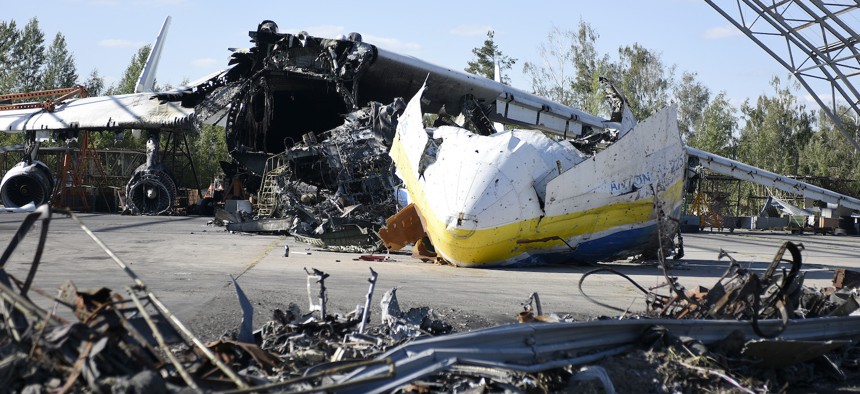
The Antonov An-225 Mriya, the world's largest cargo plane, destroyed by Russian troops is pictured at Antonov Airport near Hostomel, Kyiv Region, northern Ukraine. Ruslan Kaniuka/ Ukrinform/Future Publishing via Getty Images
Defense Business Brief: What a split Congress means for defense spending; Shipyard sells for just $15M; Ukraine says it will rebuild An-225; and more.
The 2022 midterms are behind us and, well, we still don’t know the results. Republicans hold a narrow majority in the House, but Senate control likely won’t be decided until after a run-off in Georgia.
What does a split Congress—assuming Democrats keep the Senate and Republicans take the House—mean for defense spending?
“We think a likely scenario is both sides negotiate for more spending—defense and nondefense,” according to Cowen analyst Roman Schweizer.
He notes that even during the Budget Control Act era defense spending increased through bi-partisian deals.
“We still think China, Russia, and other geopolitical risks are the biggest driving factors for defense spending,” Schweizer wrote in a Nov. 9 note to investors. “We think that over time, wars (either hot or cold) have been better predictors of spending than the split between White House and Congress.”
With Congress controlled by Democrats, lawmakers have added billions of dollars to the Biden administration’s defense budget requests. Capital Alpha Partners’ Byron Callan said there could be budget fights over the next two years.
“We believed that strong GOP gains in the House could set up an environment similar to 2010-11 with pitched partisan battles over appropriations and federal debt creating timing and size risk for DOD budgets,” Callan wrote in a Wednesday note to investors.
Also on the lame-duck Congress’ to-do list: Pass the fiscal 2023 defense appropriation by December and the National Defense Authorization Act.
Welcome
You’ve reached the Defense Business Brief by Marcus Weisgerber. Happy Veterans Day to all of those who are serving or who have served. Send along your tips and feedback to mweisgerber@defenseone.com or @MarcusReports. Check out the Defense Business Brief archive here, and tell your friends to subscribe!
The aerospace and defense sector added 6,000 employees in 2021, according to a new Aerospace Industries Association report. The sector grew 0.3 percent, to more than 2.10 million workers. That’s still slightly lower than in 2019, when the sector employed 2.19 million. More data here.
Three executives at Quadrant Magnetics, a Kentucky magnet company, have been arrested on federal charges of disclosing export-restricted information about U.S. weapons to China. They are also charged with supplying the U.S. Defense Department with banned Chinese-made magnets, according to the Justice Department..
“The indictment alleges that between January 2012 and December 2018, the defendants conspired to send approximately 70 drawings containing export-controlled technical data to a company located in China without a license from the U.S. government, in violation of the Arms Export Control Act and the International Traffic in Arms Regulations,” the Justice Department said in a statement announced after the three individuals were arrested this week. “The technical data drawings were the property of two U.S. companies and related to end-use items for aviation, submarine, radar, tank, mortars, missiles, infrared and thermal imaging targeting systems, and fire control systems for DOD.”
The China-made magnets were sold to two U.S. companies for use on F-16 and F/A-18 fighter jets, according to the statement. If convicted on all counts, the trio faces decades in prison.
The B-21 stealth bomber unveiling is less than a month away, but this week a new unit patch appeared on socal media. The patch, which features the grim reaper, a crow, and the roman numeral 17, is very similar to one that first appeared four years ago, but with a few minor changes. Like its predecessor, the patch says “Combined Task Force” on the bottom, a reference to the Edwards Air Force Base unit that will put the B-21 through the paces once it enters flight testing. Last year, then-Air Force Global Strike Command boss Gen. Timothy Ray visited the Combined Task Force at Edwards.
The U.S. State Department approved the sale of eight High Mobility Artillery Rocket System units to Lithuania. It’s the third HIMARS deal approved this year—the previous two were for Australia and Estonia. That’s not counting the HIMARS units the U.S. military has given to Ukraine. Last month, HIMARS-maker Lockheed Martin said it would increase HIMARS production amid increased demand.
Ukrainian planemaker Antonov said design work has begun to rebuild the An-225, the monster six-engine cargo plane destroyed by Russia at the beginning of its invasion of Ukraine. The company said in a Tweet that about 30 percent of the parts for the new plane already exist, an apparent reference to a decades-old An-225 that was never finished. In 2016, Antonov said it would partner with China to finish building the second aircraft, but that never happened. The company now estimates the cost of finishing the plane at around $500 million.
Bollinger Shipyards has entered an agreement to buy Pascagoula, Mississippi-based VT Halter Marine and ST Engineering Halter Marine Offshore for $15 million from Singapore-based ST Engineering. VT HalterMarine and ST Engineering Halter Marine Offshore lost $256 million on the two companies between 2017 and 2021, ST Engineering said. VT Halter Marine is building the Polar Security Cutter for the U.S. Coast Guard. After the sale is finalized, Bollinger might have to pay ST Engineering $10.25 million, “subject to the award of certain future shipbuilding contracts to Halter Marine and such contracts meeting the requisite operating profit margins.”




